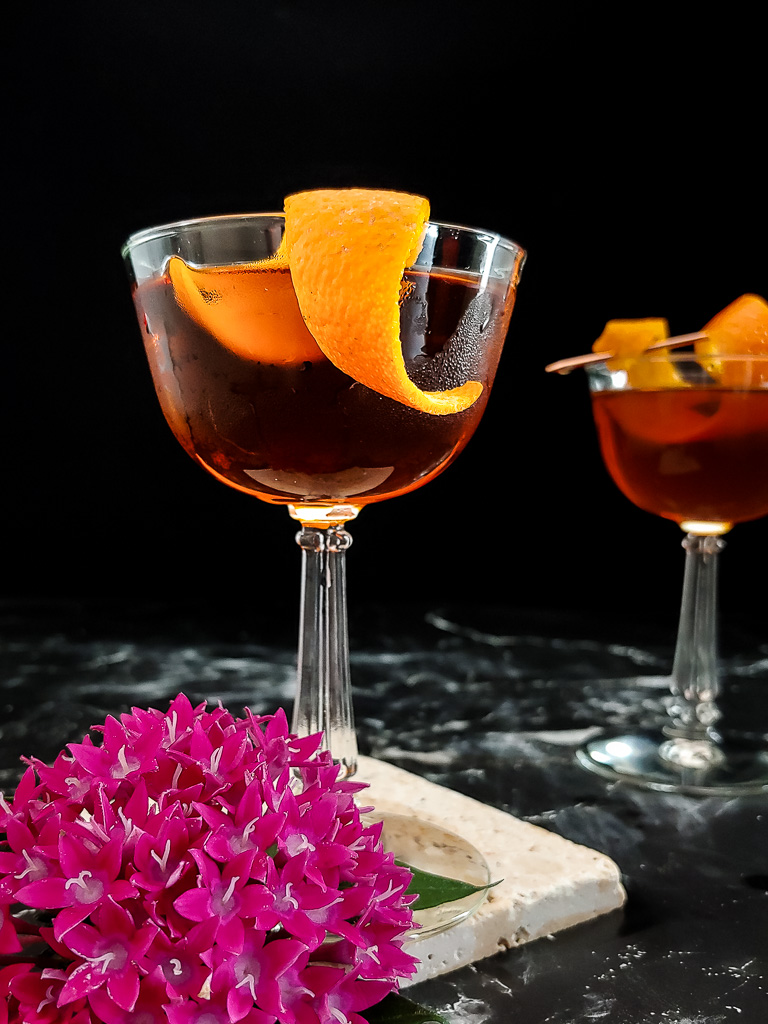
The Classic Bourbon Manhattan cocktail sits at the top of the bourbon cocktail hierarchy. A great Manhattan carries the sweetness and the high proof heat of the whiskey with all of its complexities and adds a bit of the infusion of flavors from a vermouth. A few dashes of bitters tame the collective sweetness from the whiskey and vermouth and bring out more subtle notes of from the combination of whiskey and vermouth. It a chorus of lovely whiskey notes with each sip.
The Manhattan cocktail, excellent when made well, features the taste of bourbon throughout each sip when constructed thoughtfully. Although not as common as a martini, it’s a staple at any bourbon gathering. It’s also an easy drink to master and personalize.
Whiskey drinkers love the Manhattan cocktail because bourbon (or rye) is the center of attention. The cocktail is absolutely glorious when done well.
(Post may contain affiliate links.)
History of the Manhattan Cocktail
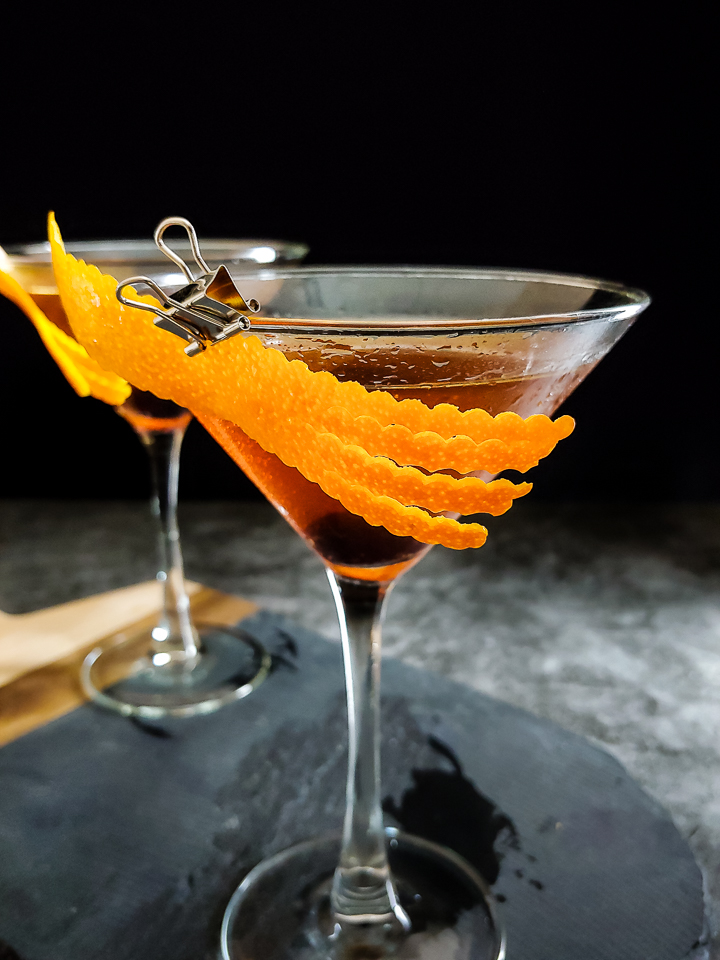
Like most other older drinks, the history of the Manhattan cocktail recipe is murky. The first print mention was in 1884 from The Modern Bartenders Guide, but it was probably around earlier than that. It’s been in the shadow of the martini for the past 40 years, but was created before the martini and was one of the earliest uses of vermouth in a cocktail.
Early stories about its origin pointed to its creation at the Manhattan Club where Lady Randolph Churchill hosted a celebration for a political campaign for Samuel J. Tildon. But, that’s been debunked by David Wondrich. Now, there’s an alternate theory that it came from “a man named Black, who kept a place ten doors below Houston Street on Broadway in the 1850s,” a quote from William F Mulhall, who worked at Hoffman House in the 1880s.
Similar to most celebrated cocktails its origins are mysterious and unknown. But that doesn’t make the drink any less delicious. For far more on the cocktail and its origins, this Bloomberg article is a great read.
How to Make a Manhattan Cocktail
Manhattan cocktail recipes are simple. Generally it’s a 2 to 1 ratio of whiskey to vermouth with a few dashes of bitters, stirred (not shaken) and strained into a chilled coupe or martini glass.
For a cocktail with so few ingredients, the selection of each element greatly impacts the final cocktail.
Bourbon or Rye?
Given the origin of the Manhattan cocktail in New York, it’s very likely the earliest versions were made with rye whiskey, not bourbon, although bourbon is very common in Manhattans today. During Prohibition, when distilleries in the US were shut down, imported rye whiskey from Canada was likely the base spirit.
That being said, the primary guidance I would give is to start with an American whiskey, and one you love. Since it will be the primary content of the Manhattan cocktail, it’s important you choose one you know you already enjoy.
I enjoy my Manhattan with bourbon or rye.
What is Vermouth and What Kind Do I Use in a Manhattan?
Vermouth is a fortified wine. It’s a wine combined with higher proof spirits (often brandy) and aromatized with herbs, roots, barks and other plant parts. Each brand of vermouth has its own set of infusions used to add flavor and aroma to the vermouth.
There are two main types of vermouth, sweet (also referred to as red or Italian) and dry (white and French). In addition, many subsets of types of vermouth with dry reds and sweet whites add complexity to your choice of vermouth.
As a fortified wine, it has a slightly higher alcohol content than wine, generally 16 to 18% alcohol by volume. While still higher than unfortified wines at 9-14% it’s low enough than an opened bottle needs to be refrigerated.
For a classic Manhattan, use a higher-end sweet vermouth. My two favorites are Carpano Antico Formula and Cocchi Vermouth di Torino. Both come in 375mL bottles easier to use up in home consumption. Many people enjoy Noilly Prat and Vya sweet vermouths, but I find them a little too bitter to my taste. When combined with the higher proof whiskies I like to use, they lack complexity.
However, if you have a favorite vermouth already, or you know you love Noilly Prat Rouge or Vya Sweet in other cocktails, use what you have and know. Use the bitters to add complexity and layers of flavor to the bourbon that you use in the Manhattan cocktail.
Bitters for your Manhattan Cocktail
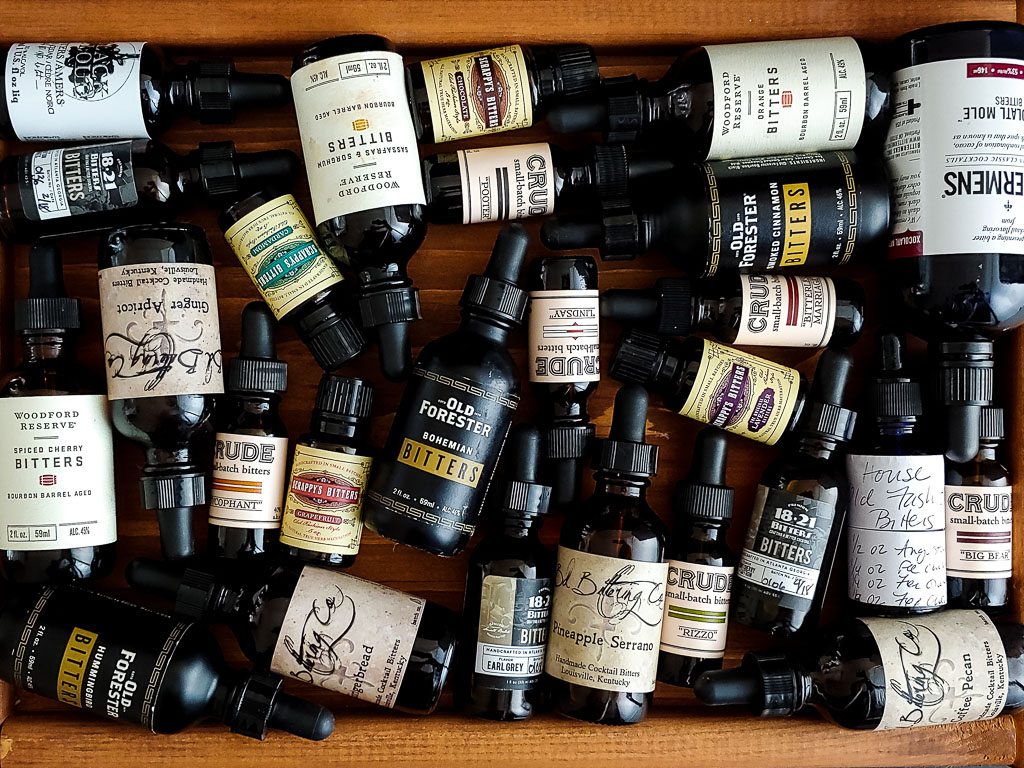
Bitters don’t just add bitterness, they round out flavors and tie disparate flavor elements in a cocktail together. For more on bitters and how they’re used in bourbon cocktails go to the start of my 3-part article on them here. In essence, bitters are the spice rack for your Manhattan cocktail, so you want to use them wisely. They can be used to bind flavors together or to add a new flavor or aroma note to a cocktail.
Many mixologists and bartenders prefer to use Angostura as the gold standard for a classic vintage cocktail like the Manhattan. Many also play with the bitters according to the specific notes of the whiskey or vermouth they are using. Some, like me, add cherry and/or orange bitters to Manhattans when the cocktail needs a a lift to tie it to the garnish and bourbon aromas.
We can play with bitters for hours with the Manhattan, but I’ll keep to the classic Manhattan ingredients here that points to the following popular choices: Angostura, orange, and aromatic bitters (with the less common cherry bitters added here as well.)
Later this week I’m discussing variations of the classic Manhattan cocktail, so I’ll cover possible bitter variations in that article.
What Bourbon or Whiskey Goes Best in my Manhattan?
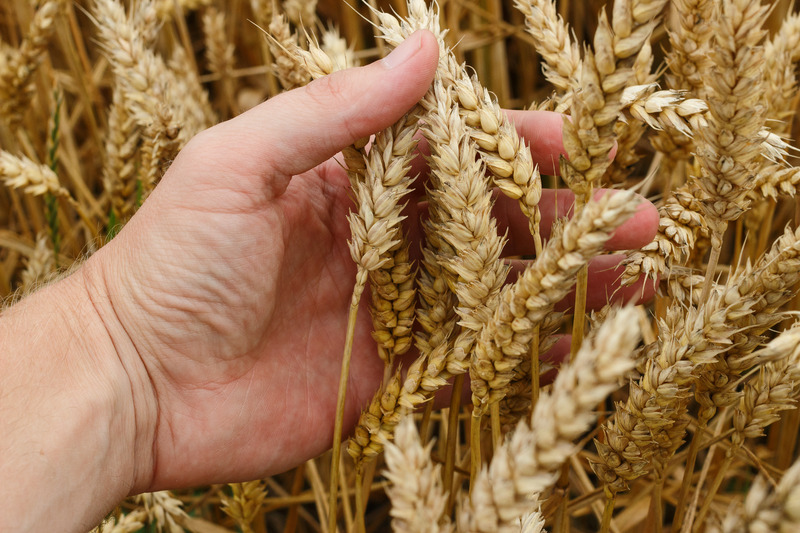
To me, this question is akin to asking my favorite bourbon. It may seem strange that I don’t have one favorite bourbon or rye, but it’s asking me to choose a favorite child. I like different whiskies best depending on the occasion, my mood, what I’ve had to eat that day, and the people I’m enjoying it with.
But for you to find your best whiskey for your Manhattan, there are some considerations for you:
Would you prefer to work with a bourbon or a rye? Some folks are solidly in the bourbon camp or the rye camp. If you already have a preference, build with that flavor profile in mind. If you don’t have a preference, think about what whiskies you love to drink neat or on the rocks. Since the Manhattan ingredients make the cocktail spirit-forward – the flavor of the whiskey will be at the forefront. What are you in the mood for? If you’ve had a fantastic Manhattan at a restaurant or bar, ask the team there what they use.
The next bourbon consideration: do you want to use a wheated or a rye bourbon? (Wheated bourbon uses wheat as the flavoring grain, and rye uses rye grain. But, both must comply with at least 51% corn as part of the mash bill to follow bourbon regulations.) Wheated bourbons generally taste sweeter with a less aggressive finish and are very smooth sippers. Rye bourbons have more bite in the mouthfeel, taste and finish, but represent the taste of a classic bourbon. There are far fewer wheated bourbons than rye bourbons.
Sometimes folks refer to wheated bourbons as “starter” bourbons as they’re more approachable for those new to the bourbon game. Doesn’t mean they’re not as tasty or fun, just a different flavor profile. Maker’s Mark, Larceny and Weller are three popular wheated bourbons, as an example.
When making a classic Manhattan cocktail, I generally use mid-range bourbon. For me, that means whiskies at the $30-40 price range, and ones l easily sip neat or chilled. I look for whiskies with a nice range of flavor and with a great finish – one that lasts. Once diluted the finish won’t be as aggressive. If I want to retain that part of the experience of drinking the Manhattan cocktail I choose a longer, more aggressive finish in my whiskey.
I can’t tell you for certain which whiskey will make the best cocktail for yoiu. However, I can point you in the right direction on considerations to start with to select your whiskey.
Once you’ve selected your whiskey, your vermouth and your bitters, I’ve got tips and tricks to keep your Manhattan cocktail experience elevated.
Tips to Make a Great Bourbon Manhattan Cocktail
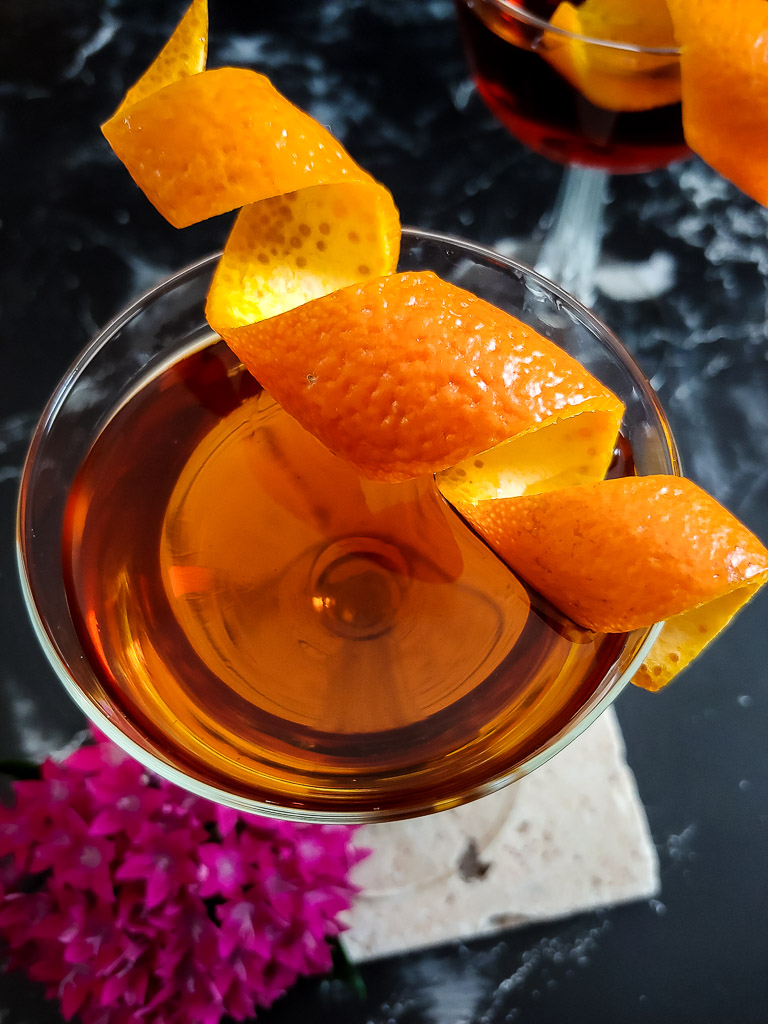
Keep Your Vermouth Refrigerated
(Please, I’m begging you!). Many people don’t realize vermouth, once opened, needs refrigeration. Because of its low alcohol content, its shelf life once opened is short, just like an open bottle of wine. If refrigerated, it can last two to four weeks before the flavor degrades.
The best Manhattan cocktails will be the ones you make within a week of opening and refrigerating your vermouth.
Have I used vermouth older than 3 or 4 weeks to make a Manhattan? Yes. When I was desperate, and I was on my second cocktail. (Or I’d already had something strong to drink so my palate was not great shape).
Dilute Well
The amount of time you should stir a Manhattan cocktail (and let me be clear, you stir the Manhattan, you don’t shake it) varies by type of ice. It depends on if your ice is slow- or fast-melting, how large the ice cubes are, and whether or not the ingredients were chilled prior to mixing.
Generally, I will stir a Manhattan for 20-30 seconds at home. If I’m using ice cubes from my freezer, I’ll err on the shorter side. If I use larger, clear ice for cocktails, I stir a little longer as one large rock melts slower than small cubes.
Chill the Glass in Advance
We’re not serving this Manhattan cocktail on the rocks (although some prefer it that way), so make sure the glass is well-chilled prior to adding the cocktail. I keep the coupe or martini glass in the freezer or fill it with ice before I begin the cocktail.
Be a Mad Scientist about Your Bitters
Don’t be stingy with your bitters. They are a huge part of why a Manhattan cocktail works. If working with a recipe that calls for a dashes, a vigorous shake is called for, not dribbling a few drops out of the top of a dasher bottle.
If you’re uncertain what bitters to use, pick a few combinations you think you might enjoy. Pour your Manhattan into three small glasses. Add a small amount of the bitters to each and taste test to find your preference.
I’d much rather you taste-tested your way to a favorite Manhattan ingredient than just followed a recipe blindly. Taste is personal. Make it yours.
Play with Proof
The proof, or alcohol by volume, of the whiskey you use will drive the flavors, heat and finish of the cocktail. Use a higher proof whiskey, about 105 or so, (like I do) and you’ll have more of the finish retained with each sip of the Manhattan cocktail. The bourbon flavor will still hold up well under the increased dilution of the finished cocktail. You’ll still have a bit of that heat from the alcohol’s proof with each sip.
However, choose a lower proof whiskey, something in the 85-95 range, and that will keep the cocktail sweeter, easier to sip and much smoother. It will allow the more delicate fruit notes that play better at a lower proof to blend with the sweet vermouth. It will decrease the overall amount of cocktail you or your guests consume and keep everyone drinking responsibly.
Garnish Your Manhattan Cocktail Well

There are two traditional garnishes for the Manhattan – an orange peel and a cherry. Some prefer to use just the cherry, and a high-quality cherry at that (talking about you, Luxardo). Others express the oils from an orange peel onto the drink, rub the peel against the rim, and place the twist in the drink.
Still others might use a lemon peel or a dehydrated citrus chip – but these are less common.
To stick to the basics, use a paring knife or peeler to create a swath of orange peel. Pinch the orange peel over the drink with the outside of the orange peel facing the drink to express the oils. Drop the orange in the drink or twist it and rest it on the rim.
Conclusion: a Classic Bourbon Manhattan Recipe
After all that information, are you ready to start mixing your own Manhattan cocktails? Don’t let these tips overwhelm you, we’re really sticking to the 2 parts whiskey, 1 part vermouth, 2 dashes bitters camp for this. All you need to do is pick out the whiskey, vermouth and bitters, and hopefully this article gave you a good place to start.
If you’ve already mastered the classic and want to know more about some of the best Manhattan variations out there, head here.
I’ll close out with my favorite Manhattan cocktail recipe for you. . .
Recommended Bar Tools
You don’t need every slick, beautiful bar tool out there, but there are several I’ll recommend. (As an Amazon Associate I earn from qualifying purchases. However, that does not affect the cost of the items below.) My favorite pieces usually come from the Cocktail Kingdom section of Amazon:
You may already have these bar essentials, but just in case:
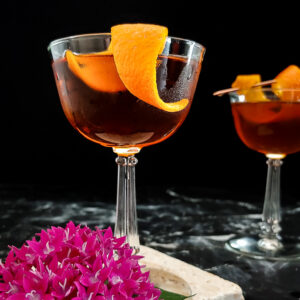
Classic Manhattan Recipe
Ingredients
- 2 oz 100 proof bourbon I use Early Times Bottled in Bond or Johnny Drum
- 1 oz Cocchi Vermouth di Torino sweet vermouth
- 16 drops Bohemian Bitters aromatic bitters
- 8 drops spiced cherry bitters
- 8 drops orange bitters
- Garnish: orange peel and optional cherry
Instructions
- Combine vermouth, bourbon and bitters in a mixing glass and fill with ice.
- Stir until well-chilled and strain into a chilled coupe.
- Express the oils from an orange peel over the cocktail and garnish with the peel. Add a cherry if you like.